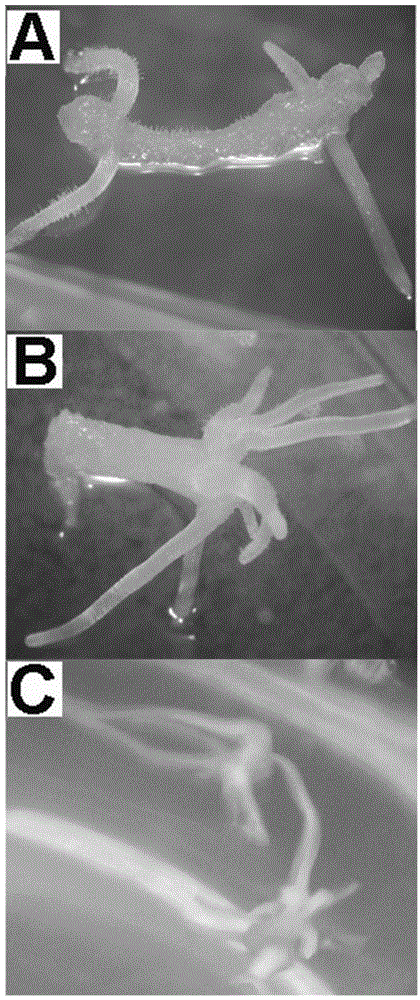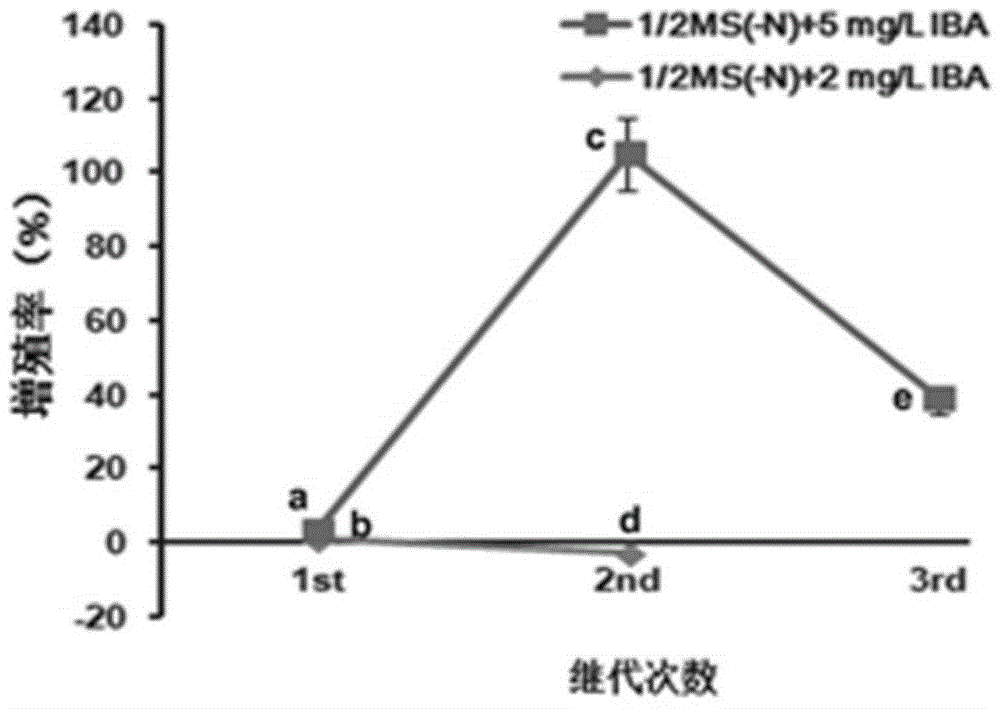Ginseng adventitious root induced proliferation method
A technology of ginseng and induction medium, which is applied in the field of plant tissue culture, can solve the problems of long experimental period, etc., and achieve the effect of increasing the number of adventitious roots, good proliferation effect, and shortening the time
- Summary
- Abstract
- Description
- Claims
- Application Information
AI Technical Summary
Problems solved by technology
Method used
Image
Examples
Embodiment 1
[0051] This example is used to illustrate the use of ginseng tissue culture seedling roots to induce adventitious roots.
[0052] Get the roots of ginseng tissue culture seedlings, cut them into small sections of about 5 mm × 5 mm × 3 mm with a sterilized knife, and transfer them to the solid induction medium containing 1 / 2MS(-N)+2mg / L IBA (in the solid induction medium Contain 2% sucrose, 7g / L agar, pH value is 5.8), induce the production of adventitious roots under dark conditions at 24±2°C. Each dish was inoculated with 30 explants, subcultured every three weeks during the induction culture process, and the adventitious root induction rate and the number of adventitious roots produced by each explant were counted. The experiment was repeated 3 times, and the average value was taken. The results are listed in Table 1.
[0053] The result shows that after three weeks of cultivation, all roots can induce adventitious roots, and only one adventitious root is induced on each roo...
Embodiment 2
[0055] This example is used to illustrate the proliferation and culture of adventitious roots induced by ginseng tissue culture seedling roots.
[0056] The adventitious roots induced by the roots of ginseng tissue culture seedlings obtained after six weeks of induction in Example 1 were taken out, cut into small pieces of 1 cm size, and inserted into small pieces containing 100ml 1 / 2MS(-N)+2mg / L IBA +20g / L sucrose in a culture bottle of liquid medium, placed in a shaker at 24±2°C under dark conditions and slowly oscillating (60rpm) to carry out proliferation of adventitious roots. Subculture once every three weeks, and count the fresh weight of adventitious roots, the experiment was repeated 3 times, and the average value was taken. The cultured adventitious roots were taken out, the sterilized filter paper absorbed the culture solution on the surface, and placed on a balance for weighing, which was the fresh weight. Calculate the proliferation rate of adventitious roots, th...
Embodiment 3
[0058] This example is used to illustrate the proliferation and culture of adventitious roots induced by ginseng tissue culture seedling roots.
[0059] According to the same method as in Example 2, the adventitious roots induced by the roots of ginseng tissue culture seedlings were proliferated and cultured. The only difference is that the liquid proliferation medium used is 1 / 2MS(-N) liquid proliferation medium containing 5mg / L IBA and 20g / L sucrose. Calculate the proliferation rate of adventitious roots, the results show that ( figure 2 A): After three weeks of proliferation culture, the proliferation rate was 24.4%; after six weeks of proliferation culture, the proliferation rate was 32.27%, and after nine weeks of culture, the proliferation rate was 22.25%.
PUM
 Login to View More
Login to View More Abstract
Description
Claims
Application Information
 Login to View More
Login to View More - R&D
- Intellectual Property
- Life Sciences
- Materials
- Tech Scout
- Unparalleled Data Quality
- Higher Quality Content
- 60% Fewer Hallucinations
Browse by: Latest US Patents, China's latest patents, Technical Efficacy Thesaurus, Application Domain, Technology Topic, Popular Technical Reports.
© 2025 PatSnap. All rights reserved.Legal|Privacy policy|Modern Slavery Act Transparency Statement|Sitemap|About US| Contact US: help@patsnap.com



